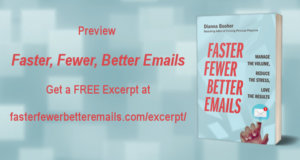


(This article first appeared in Indian Management.)
Email saves an enormous amount of time for those who think strategically. For those who don’t, the back-and-forth clutter can clog up their inbox for hours or days. Let’s assume you fall into the strategic-thinkers group that likes the one-and-done email plan.
My new book Faster, Fewer, Better Emails: Manage the Volume, Reduce the Stress, and Love the Results (Berrett-Koehler) introduces the following strategic questions to guide your thinking process BEFORE you start to compose.
Instead of composing an email about a situation or topic and then deciding who should get a copy, reverse the process. Consider who has interest in the situation: One reader? Your project team? The entire client organization? If you’re writing outside your organization, will your client or vendor likely pass your email on to still other advisors for input, decision, or action?
Assess the audience carefully so that, if practical, one email can handle the entire situation from beginning to end. That is, you can email your primary reader with all the appropriate information so he or she can forward your email to a staffer, delegating the action steps. No further “clarifying” emails from you will be necessary.
For example, can you email client Jeremy that his project is completed and simply copy your finance specialist so she knows to initiate the invoice?
Why will readers care about what you have to say? What does your message mean for how they will do their job the next day or month? How can you summarize that message to them in a sentence or two? Your readers must see immediate relevancy. Forget “background.”
Far too often, people send “So what?” emails. That is, readers get to the end of the email and then ask, “So what do you want me to do about this?” The specific action is either missing or vague. Before you write, consider what you want the reader to do, buy, join, attend, approve, review, or reply about—and state that very clearly upfront.
Try not to tell them that. This guideline might seem like common sense—but it’s not common practice. Writers often spend one, two, three, or even more paragraphs providing background before they get to the point. Examples: Summarizing a meeting. Repeating a question before providing the answer.
As a result, readers often stop before they get to the core message, thinking the email is redundant, irrelevant, and/or irritating.
With this question, you may decide not to email at all, but rather to text, phone, or meet face to face. Or you may restructure your message altogether. If you need to send changes to a procedure, would readers find it cumbersome to continue to refer back to your email? How about creating a checklist for quick reference instead?
For example, if you’re sending a new procedure to a manager in another department, the best approach might be to overview the change in the body of an email and attach the detailed procedure so the manager can circulate it to his or her entire operations team.
The more questions you ask and answer for yourself upfront, the better emails you write—and the quicker, more relevant responses you get.
Learn more ways to streamline your email process in Faster, Fewer, Better Emails: Manage the Volume, Reduce the Stress, and Love the Results. Click here for a free excerpt.
